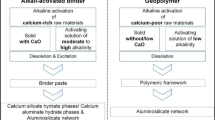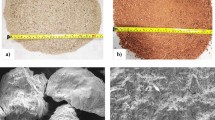Abstract
The water extraction out of mortar during brick laying was studied using nuclear magnetic resonance. The experiments show that using a fired-clay brick, the water is extracted out of the mortar within 3 minutes, whereas in the case of a sand-lime brick this takes about 10 minutes. Prewetting a fired-clay brick hardly affects the water extraction, whereas prewetting a sand-lime brick slows down the water extraction, although the effect is small. The extraction process is slowed down only if the bricks are almost fully saturated. These effects are explained with the help of computer simulations. The final moisture content of the mortar is shown to depend on the suction of the brick and thereby on the equilibrium moisture content of the brick. By adding a water retention agent to the mortar, the extraction process seems to slow down, although the final moisture content of the mortar is not changed.
The water extraction experiments suggest that the suction of the mortar which is formed depends on the water extraction rate and thereby on the type of brick that is used in the extraction experiment. Petrographic analyses indicate that the extent of bonding between the brick and the mortar is different for fired-clay brick and sand-lime brick.
Résumé
L'extraction de l'eau du mortier par la brique a été étudiée par la méthode de résonance magnétique nucléaire. Les résultats montrent que les briques en terre cuite extraient l'eau du mortier en 3 minutes, alors que dans le cas de briques à base de chaux ce temps augmente à 10 minutes. L'humidification préalbble des briques en terre cuite a peu d'influence sur leur extraction de l'eau; dans le cas des briques à base de chaux, l'humidification préalable ralentit l'extraction, mais très légèrement. L'absorption de l'eau du mortier par la brique est sensiblement ralentie lorsque les briques sont préalablement saturées d'eau. Ces phénomènes sont expliqués grâce à des simulations numériques. La teneur en eau finale du mortier dépend de l'aspiration de la brique et donc de la teneur en eau à l'équilibre de la brique. L'ajout d'un agent rétenteur d'eau au mortier semble ralentir l'extraction de l'eau par la brique sans pour autant changer la teneur en eau finale du mortier.
Les résultats suggèrent que l'aspiration du mortier dépend du taux d'extraction d'eau par la brique et donc du type de brique utilisé. L'analyse pétrographique montre que l'adhérence mortier-brique est différente pour les briques en terre cuite et celles à base de chaux.
Similar content being viewed by others
References
Détriché, C.H. and Grandet, J., ‘Influence de la suction des support poreux sur la prise et la résistance au cisaillement des mortiers moulés à leur contact’,Mater. Struct. 14 (1981) 91–102.
Groot, C., ‘Effect of water on mortar-brick bond’, Ph. D. Thesis, Delft University of Technology, The Netherlands, 1993.
Anderegg, F.O., ‘The effect of brick absorption characteristics upon mortar properties’,ASTM-Proc. 42 (1942) 821–836.
Philip, J.R. and de Vries, D.A., ‘Moisture movement in porous materials under temperature gradients’,Trans. Am. Geophys. Un. 38 (1957) 222–232.
Whitaker, S., ‘Simultaneous heat, mass and momentum transfer in porous media: A theory of drying porous media’,Adv. Heat Transfer 13 (1977) 119–200.
Bear, J. and Bachmat, Y., ‘Introduction to Modeling of Transport Phenomena in Porous Media’, Vol. 4 (Kluwer, Dordrecht, the Netherlands, 1990).
Pel, L., Kopinga, K., Bertram, G. and Lang, G., ‘Water absorption in fired-clay brick observed by NMR scanning”,J. Phys. D: Appl. Phys. 28 (1995) 675–680.
Pel, L., ‘Moisture transport in porous building materials’, Ph.D. Thesis, Eindhoven University of Technology, The Netherlands, 1995.
Gardner, W.R. and Mayhugh, M.S., “Solutions and tests of the diffusion equation for the movement of water in soil’,Soil. Sci. Soc. Am. Proc. 22 (1958) 197–201.
Kopinga, K. and Pel, L., ‘One-dimensional scanning of moisture in porous materials with NMR’,Rev. Sci. Instrum. 65 (1994) 3673–3681.
Heijnen, W.M.M. and Larbi, J.A., ‘Microscopie van beton’,Materialen 10 (1992) 9–16.
Author information
Authors and Affiliations
Additional information
Editorial note H.J.P. Brocken works at the Department of Architecture, Building and Planning, Eindhoven University of Technology, a RILEM Associate Member L. Pel and K. Kopinga also work at the Eindhoven University of Technology. M. E. Spiekman works at the Department of Civil Engineering, Delft University of Technology, a RILEM Associate Member, J. A. Larbi works at TNO Building and Construction Research, a RILEM Titular Member.
Rights and permissions
About this article
Cite this article
Brocken, H.J.P., Spiekman, M.E., Pel, L. et al. Water extraction out of mortar during brick laying: A NMR study. Mat. Struct. 31, 49–57 (1998). https://doi.org/10.1007/BF02486414
Received:
Accepted:
Issue Date:
DOI: https://doi.org/10.1007/BF02486414




